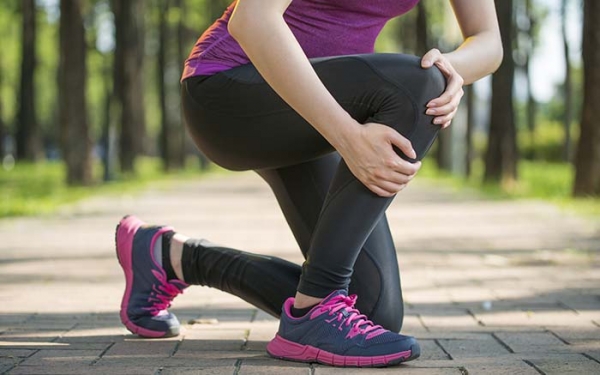You may be surprised to learn that a lot of the problems you have with your feet might also be the cause of your knee pain. Here’s a quick look at some of the conditions and diseases that can cause a combination of foot and knee pain.
Flat Feet
Many people with flat feet find that their ankles roll inward with each step. This excessive inward rotation of the ankle, tendons, and ligaments connecting the muscles and bones of the heel and shin bone will cause the inside of the lower leg to stretch further than the outside. As the lower leg is pulled out of line, the knee fails to track straight, causing knee pain.
There are a few ways in which you can tell if you have flat feet:
- Get your feet wet and make an impression on a dry patch of flooring. The inside of the impression should be dry, as a healthy arch wouldn’t have made contact with the floor.
- Place the soles of your feet together. Check to see if each instep is virtually in contact along the length of your feet, or whether there is a good parting of the feet around the midsection.
- See if you can comfortably insert your thumb under your instep while standing.
Osteoarthritis
Osteoarthritis occurs when the protective cartilage one the ends of your bones wears down over time. With osteoarthritis, the slick surface of the cartilage becomes rough and may eventually wear down completely, causing bone to rub on bone. It can damage any joint in your body, including your feet and your knees.
The symptoms of osteoarthritis often develop slowly and worsen over time. Symptoms include:
- Pain
- Tenderness
- Stiffness
- Loss of flexibility
- Grating sensation
- Bone spurs (extra bits of bone that feel like hard lumps)
Rheumatoid Arthritis
Rheumatoid arthritis is a chronic inflammatory disorder that can affect more than just your joints. In some people, the condition can also damage a wide variety of the body’s systems, including the skin, eyes, lungs, heart, and blood vessels. Rheumatoid arthritis affects the lining of your joints, causing a painful swelling that can eventually result in bone erosion and joint deformity.
The condition occurs when your immune system attacks the synovium (the lining of the membranes that surround your joints). The resulting inflammation thickens the synovium, which can eventually destroy the cartilage and bone within the joint. The tendons and ligaments that hold the joint together weaken and stretch, gradually causing the joint to lose its shape and alignment.
Tendinitis
Tendinitis, or tendonitis, is an inflammation or irritation of a tendon (a thick cord that attaches the bone to muscle. It is most often caused by repetitive, minor impact on the affected area, or from a sudden more serious injury. Incorrect posture at work or home, or poor stretching or conditioning before exercise may increase your risk of tendinitis. Tendinitis can occur almost anywhere in the body where a tendon connects muscle to bone, and can affect anyone of any age.
Symptoms of tendinitis include:
- Pain at the site of the tendon and surrounding area
- Loss of motion
Bursitis
Bursitis in a painful condition that affects the small, fluid filled sacs (bursae) that cushion the bones, tendons, and muscles near your joints. Bursitis occurs when bursae become inflamed, and most often occurs in joints that perform frequent repetitive motion.
Symptoms of bursitis can cause the affected joint to:
- Feel achy or stiff
- Hurt more when you move or press on it
- Look swollen and red
Gout
Gout is characterized by sudden, severe attacks of pain, redness, and tenderness in the joints. It is a complex form of arthritis that can affect anyone, but is more common among men. Gout occurs when urate crystals accumulate in your joint, causing inflammation and intense pain. Urate crystals can form when you have high levels of uric acid in your blood. Your body produces uric acid when it breaks down purines (substances found naturally in your body), as well as steak, organ meats, and seafood.
Symptoms of gout include:
- Intense joint pain
- Lingering discomfort
- Inflammation and redness
- Limited range of motion
Treating Foot and Knee Pain
If you suspect that you have any of the above conditions or diseases, then you should schedule a consultation with Dr. Vikki and Dr. Connie. With years of collective experience in their fields, they have the experience to help you figure out what the root of your problem is.
